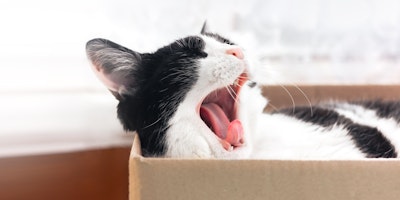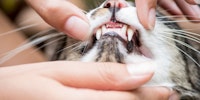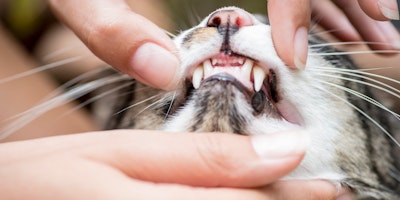
Providing cat dental care is essential in supporting your feline companion’s overall health. It’s especially important given the commonality of dental problems.
Studies show that up to 90 percent of domestic cats will experience some type of dental disease in their lives, according to Cornell University’s College of Veterinary Medicine.
The good news is tooth and gum issues in felines are often preventable. From regular cleaning to eating dry cat food, there are steps you can take to maintain good oral hygiene.
What Do Healthy Cat Teeth Look Like?
Healthy cat teeth should be clean and white without any chipping. If you’re examining the inside of your pet’s mouth, don’t forget to check their gums as well. Gums should be pink and free of swelling and lesions.
Contact your veterinarian if you see any of the following signs as they may indicate dental disease:
- Discolored or damaged teeth
- Tooth loss
- Bad breath
- Swollen or bleeding gums
- Drooling
Cat Dental Problems
Without regular dental care, many felines develop periodontal disease (a progressive infection of tissue surrounding the teeth) before they turn three years old, according to the American Animal Hospital Association.
Unfortunately, pain from dental disease can be significant but you may never know it, as cats are good at hiding their discomfort.
If you want to provide good cat oral care, it can help to know the issues that may affect your pet.
Here are some of the most common types of cat dental problems:
Plaque
The food your cat eats can leave behind an invisible layer on their teeth called plaque. The film can harden fairly quickly—usually after a few days—to form calculus, also known as tartar. If calculus begins building up, it can irritate the gums.
Gingivitis
After calculus (formed by plaque) accumulates on the teeth, it can cause a bacterial infection that leads to inflamed gums. This inflammation is known as gingivitis. If gingivitis is untreated, it may destroy gum tissue, which can cause loose teeth and/or tooth loss.
Resorption
Resorption occurs when the structure of the tooth breaks down because—for unknown reasons—the body starts to absorb it. Typically, it happens below the gumline, near the roots.
Cat Dental Care Tips
Cats may not love having their teeth inspected, but minding dental health can help prevent disease.
Here’s how to promote healthy teeth in your cat.
Get Cat Oral Care by a Professional
Oral exams by your veterinarian should begin when a kitten is around two months old, followed by a checkup between six months and one year. After that, their teeth and gums should be checked at least annually.
A full dental examination usually includes mouth X-rays so your veterinarian can get a complete view of your pet’s teeth and gums.
Using dental tools, they will also perform a thorough cleaning, removing plaque and calculus from the teeth as well as from the crowns and roots.
Additionally, your veterinarian may polish your cat’s teeth.
Remember, routine examinations and cleanings can be effective at preventing dental disease.
Brush Your Cat’s Teeth
As with humans (and dogs), brushing your pet’s teeth can help remove plaque and calculus while promoting healthy gums. A good cadence is to brush daily or twice-weekly, if possible. You can start once your kitten has their adult teeth.
Be careful, though—wait for your veterinarian to do an oral examination before you try brushing. They’ll alert you to any painful areas you should avoid.
Learn more about how to clean your cat’s teeth, including instructions on how to brush.
Feed Tooth-Friendly Foods
Many cats love the taste and texture of wet food. While it may be a good choice for your pet, wet food can easily get stuck in your feline’s teeth. If the food isn’t removed through brushing or another way, it can cause plaque to buildup.
As an alternative, dry, crunchy foods can be helpful in keeping a cat’s teeth clean. As the cat chews, particles from the dry food scrape against the teeth, acting like a toothbrush to help remove plaque. Cats that consume dry food can also experience dental disease so it’s important to have your cat regularly examined by a veterinarian.
If you don’t want to completely replace the wet food your cat craves, you can also try mixing wet and dry. Talk to your veterinarian about getting the right proportion of each.
Another option? Dental treats for cats.
Similar to the dental benefits of kibble, these treats can help reduce tartar buildup.
Check in With Your Veterinarian
If your cat refuses to allow you to clean their teeth, it’s okay to leave it to the professionals. Talk over a specific cleaning schedule with your veterinarian—and expect to at least take your cat in for an annual cleaning.
With the right amount of effort and attention, you’ll be on your way to promoting healthy oral hygiene for your cat.
Want additional feline health tips? Learn more from our experts on our Pet Expertise page.
Related articles


Earn myPurina Rewards with Every Purchase
Use your points for treats, toys, and gift cards with myPurina app.


